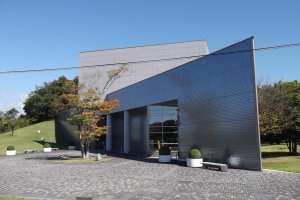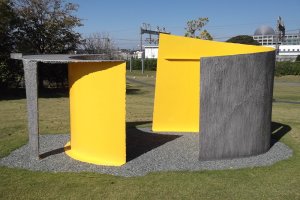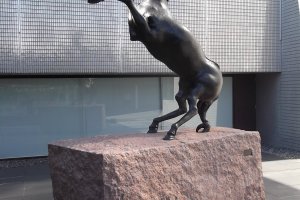One of Japan's largest beauty and skincare companies, Shiseido was founded in 1872, when the country's first Western-style pharmacy was opened in Ginza in Tokyo. In 1919 they opened the Shiseido Gallery, now the oldest gallery in Japan, which holds regular exhibitions of work by young Japanese artists. That isn't their only artistic endeavour, though; near their Shizuoka factory in Kakegawa, about twenty minutes' walk from Kakegawa station, there's the Shiseido Art House and Corporate Museum, very different but equally interesting places.
At the entrance to the Art House there's one of Lee Ufan's very minimal sculptures, of rocks and metal, but the rest of the exhibition I saw was of charming Japanese paintings from the 1930s and 40s. They were of unfussy subjects in gentle colours; a woman being tattooed, views of homes, women looking at cherry-blossom trees, all creating a restful feeling. There were also a few books on display, opened to pages where drawings by the same artist were used as illustrations.
Round the corner were more sculptures, in a mix of styles, with some particularly entertaining ones of women doing naked horseback acrobatics. Then there was another, larger room of books dating back to the 1910s-30s, kept in display cases like artefacts of an ancient civilization. They were showing off their cases, covers and interior illustrations: landscapes, flowers, a snowswept village, scenes which I assume were from the books' stories. Some of them were rather faded, some of them well-preserved with the colours still vivid, and it was fun to imagine who they belonged to, how often they were read, where, who to.
Also interesting - and also free of charge - is the Corporate Museum. It's full of items from the company's history, of course: store staff uniforms, product packaging and samples from different eras - the uniforms have changed dramatically! - scores of posters, a soda fountain. As I went round the displays I enjoyed listening to the audio guide (available in English, French, Chinese and Korean), which provided interesting insight into how the company has evolved and responded to changes during Japan's turbulent recent history.
This is reflected most clearly in the timeline display of promotional posters: they were text-heavy in the 1910s, then art-deco and racy Western styles were introduced in the 1920s, leading eventually on to 70s hippy dudes and the unabashed glamour of the 80s.
Naturally, each museum has a shop, selling a surprisingly small range of goods, such as bags, stationery, perfume and cookies. Still, I suppose that just means you have more money for cosmetics!

































